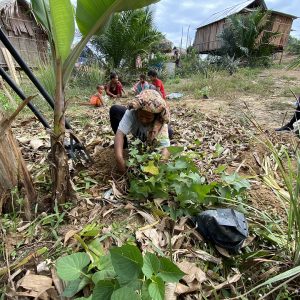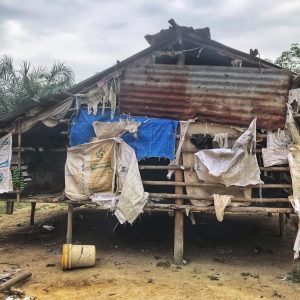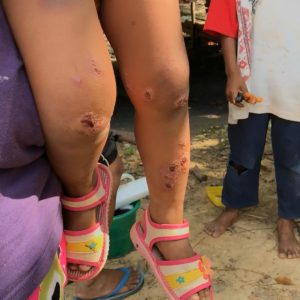
The Orang Asli We Work With

The Orang Asli population of 217,000 in Peninsular Malaysia comprises 18 tribes.

50% of the Orang Asli population is categorised as poor, with 33% living in hard-core poverty.

Many Orang Asli villages have no access to basic amenities such as paved roads, electricity, clean water supply and sanitation services and facilities.

Situated within palm oil plantations or at the fringe of the forest, the common livelihood of the Orang Asli includes farming, forest gathering and hunting.

The splinter villages commonly have 10 to 30 families.
Key Challenges of Underserved OA community
Scarcity of Clean Water
Many Orang Asli communities rely on ponds, rivers and self-dug wells as their source of water. However, these water sources are often polluted due to contamination from animal activities or chemicals from nearby plantations. Women are also disproportionately affected as they are often responsible for collecting water for daily needs. Walking up to 4 hours a day to fetch water, many of them also struggle with health problems such as backache and joint pains.
Poor Hygiene, Sanitation and Health
In their daily errand to bathe, do laundry and collect water for cooking and drinking, many Orang Asli families are exposed to devastating waterborne illnesses due to their close proximity to rivers and ponds that are often polluted. Without proper sanitation facilities, many continue to practice open defecation. This practice, compounded with animal waste and chemicals from nearby plantations, results in the widespread contamination of their land, water and food.
Energy Poverty
Many Orang Asli communities are still struggling with extreme energy poverty. Without access to electricity, many of them have no other options but to fork out a substantial portion of their income on expensive and non-renewable sources of energy such as fuels and batteries. This dependency results in financial burden, degradation of the environment and negative impacts on the long-term health of the community.
High rate of Illiteracy and Dropouts
Over 80% of Orang Asli children in our database do not attend school. This is due to a combination of remote location, poverty, lack of transportation, integration within the school and parental awareness on the importance of education. As a result, many children struggle with low-literacy skills and high school dropout rates. Many more children have also never attended school at all.
Poverty and Livelihood Challenges
Many Orang Asli build their houses using wood and leaves gathered from the forest. However, their houses do not last long due to termites and the short-term nature of using leaves as roof (attap roof), forcing many to live in dilapidated houses. Most villagers have to rebuild their homes every 2 to 3 years due to their dilapidated nature, however, many are finding it increasingly difficult to source for wood and other materials due to widespread deforestation.
Food Security and Malnutrition
With growing dependence on the cash economy, many families often only have enough money to afford basic food. As a result, malnutrition among Orang Asli children remains prevalent. Thus, many Orang Asli are interested in farming for food security. However, there are various barriers to farming such as poor soil conditions and lack of capital for seedlings, tools and irrigation systems. This, along with the lack of knowledge and skills on sustainable farming methods hinder them from becoming self-sufficient farmers.
Key Challenges of Underserved OA community
Scarcity of Clean Water
Many Orang Asli communities rely on ponds, rivers and self-dug wells as their source of water. However, these water sources are often polluted due to contamination from animal activities or chemicals from nearby plantations. Women are also disproportionately affected as they are often responsible for collecting water for daily needs. Walking up to 4 hours a day to fetch water, many of them also struggle with health problems such as backache and joint pains.
Poor Hygiene, Sanitation and Health
In their daily errand to bathe, do laundry and collect water for cooking and drinking, many Orang Asli families are exposed to devastating waterborne illnesses due to their close proximity to rivers and ponds that are often polluted. Without proper sanitation facilities, many continue to practice open defecation. This practice, compounded with animal waste and chemicals from nearby plantations, results in the widespread contamination of their land, water and food.
Energy Poverty
Many Orang Asli communities are still struggling with extreme energy poverty. Without access to electricity, many of them have no other options but to fork out a substantial portion of their income on expensive and non-renewable sources of energy such as fuels and batteries. This dependency results in financial burden, degradation of the environment and negative impacts on the long-term health of the community.
High rate of Illiteracy and Dropouts
Over 80% of Orang Asli children in our database do not attend school. This is due to a combination of remote location, poverty, lack of transportation, integration within the school and parental awareness on the importance of education. As a result, many children struggle with low-literacy skills and high school dropout rates. Many more children have also never attended school at all.
Poverty and Livelihood Challenges
Many Orang Asli build their houses using wood and leaves gathered from the forest. However, their houses do not last long due to termites and the short-term nature of using leaves as roof (attap roof), forcing many to live in dilapidated houses. Most villagers have to rebuild their homes every 2 to 3 years due to their dilapidated nature, however, many are finding it increasingly difficult to source for wood and other materials due to widespread deforestation.
Food Security and Malnutrition
With growing dependence on the cash economy, many families often only have enough money to afford basic food. As a result, malnutrition among Orang Asli children remains prevalent. Thus, many Orang Asli are interested in farming for food security. However, there are various barriers to farming such as poor soil conditions and lack of capital for seedlings, tools and irrigation systems. This, along with the lack of knowledge and skills on sustainable farming methods hinder them from becoming self-sufficient farmers.









